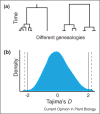Genomic variability as a driver of plant-pathogen coevolution?
- PMID: 24491596
- PMCID: PMC4696489
- DOI: 10.1016/j.pbi.2013.12.003
Genomic variability as a driver of plant-pathogen coevolution?
Abstract
Pathogens apply one of the strongest selective pressures in plant populations. Understanding plant-pathogen coevolution has therefore been a major research focus for at least sixty years [1]. Recent comparative genomic studies have revealed that the genes involved in plant defense and pathogen virulence are among the most polymorphic in the respective genomes. Which fraction of this diversity influences the host-pathogen interaction? Do coevolutionary dynamics maintain variation? Here we review recent literature on the evolutionary and molecular processes that shape this variation, focusing primarily on gene-for-gene interactions. In summarizing theoretical and empirical studies of the processes that shape this variation in natural plant and pathogen populations, we find a disconnect between the complexity of ecological interactions involving hosts and their myriad microbes, and the models that describe them.
Copyright © 2014 Elsevier Ltd. All rights reserved.
Figures


References
-
- Flor HH. Current status of gene-for-gene concept. Annu Rev Phytopathol. 1971;9:275–280.
-
- Jones JD, Dangl JL. The plant immune system. Nature. 2006;444:323–329. - PubMed
-
- Kamoun S. A catalogue of the effector secretome of plant pathogenic oomycetes. Annu Rev Phytopathol. 2006;44:41–60. - PubMed
-
- Baltrus DA, Nishimura MT, Romanchuk A, Chang JH, Mukhtar MS, Cherkis K, Roach J, Grant SR, Jones CD, Dangl JL. Dynamic evolution of pathogenicity revealed by sequencing and comparative genomics of 19 Pseudomonas syringae isolates. PLoS Pathog. 2011;7:e1002132. Through sequencing the genomes of 19 pathovars of Pseudomonas syringae and subsequent functional testing, the authors identify the full complement of effectors in these diverse strains. This study reveals the rapid turnover of effector genes in P. syringae genomes even between closely related isolates, suggesting that these genes are frequently lost and gained, and that P. syringae can adapt rapidly to new hosts. - PMC - PubMed
-
- Michelmore RW, Meyers BC. Clusters of resistance genes in plants evolve by divergent selection and a birth-and-death process. Genome Res. 1998;8:1113–1130. - PubMed
Publication types
MeSH terms
Grants and funding
LinkOut - more resources
Full Text Sources
Other Literature Sources

